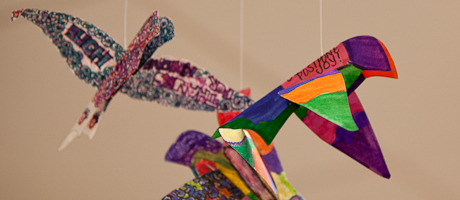By Jennifer Eder
At first glance, the entrance to the Dr. Cyrus and Myrtle Katzen Cancer Research Center in the George Washington Medical Faculty Associates looks like it could be the entrance to a luxury spa.
Calming music plays as water runs over lily pads, purple orchids and smooth pebbles.
This nature décor is part of the center’s “healing environment” that aims to set the stage for a healing journey. The center first opened in April 2009 and since then has served thousands of patients as they battle cancer.
“The whole center is very soothing and comforting during what can be a very tense time for so many people,” said 60-year-old Vickie Wilson, who is being treated for Stage 4 metastatic breast cancer.
Ms. Wilson first received treatment at the MFA’s old Cancer Center in 2008 when she was diagnosed with breast cancer. But three years later, she had a reoccurrence, and this time her cancer had spread. So in May last year, she began getting chemotherapy again, but this time it was in the Katzen Center.
“The new place is so much nicer. There’s a lot of natural light, and the whole environment makes the treatment process easier to get through,” said Ms. Wilson, who receives chemo about three times a month.
The Katzen Center was created thanks to a $10 million gift to GW from Cyrus and Myrtle Katzen. In addition to supporting the creation of the center’s “inspired-by-nature” organic design, the gift is funding a wide range of cancer initiatives, including recruitment of top cancer researchers, enhancement of clinical care and furthering education around cancer prevention and treatment. Six members of the Katzen family have attended GW, including four who earned medical degrees. And Dr. Katzen’s first wife, Sylvia, who died in 1980, received treatment at GW Hospital during her 10-year battle with cancer.
The Katzen Center’s design evokes natural settings because nature has been shown to have an effect on lowering stress and promoting healing, said Tanya Keys, director of operations at the MFA. The inspiration of nature can be seen in the artwork, the colors of the paint and even the floor tiles. And last year, the Katzen Center was recognized for its unique design when it won first place in the health care category of the American Society of Interior Designers’ Washington metro chapter.
“It’s had a very positive impact on our patients,” said Ms. Keys. “Our first cancer center was small and very tight, but now we can offer patients a much more relaxing environment.”
Inside the infusion room are 21 chairs where patients receive chemotherapy. The chairs have heated seats to provide therapeutic warmth and comfort while natural light pours in through the many windows. Patients can also check out a laptop to watch a DVD or browse the Internet as many patients are there for more than three hours.
The Katzen Center offers art therapy programs and support groups to enhance the patient experience. Jennifer Bires, a social worker at the Katzen Center, supports the psycho-social needs of the patients and their families by leading eight support groups, including those for patients in active treatment, family members and patients with specific types of cancer.
“It’s very anxiety provoking to be told you have cancer. It’s a really scary situation. Studies have shown that even walking into a cancer center can make someone nauseous,” said Ms. Bires. “That’s why we’ve created a calming scene here.”
Monica Dreyer, a GW graduate student and an art therapy intern at the Katzen Center leads patients in voluntary art therapy projects. In November, patients made a “grateful tree” by writing something they were thankful for on individual leaves. This month they’re making paper doves, which hang from the ceiling in the infusion room, and writing messages of hope on each dove.
“Art therapy gives the patients an opportunity to explore parts of their brain that they may not be attune to. It is a creative outlet that oftentimes can help patients identify different concerns or even symptoms that they are experiencing,” said Ms. Bires. “It gives patients a safe space with a professional to talk about their fears and begin to process their experience.”


